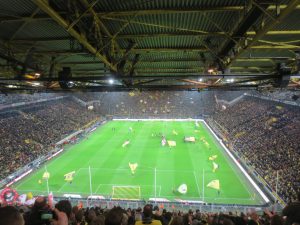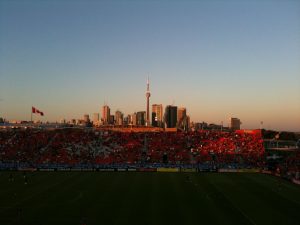By Roger Keil
As 2013 draws to a close, I am reflecting on a few critical urban books that have taught me something during the past year. Not all of them are brand new. They are not the only ones that mattered to me over the past 12 months (or have shown promise to continue doing so in future) but they have made my work and my life richer. Instead of presenting them in a ranked list, I decided to put them into the shape of a football (soccer) team. This is a playful homage to critical writing that means much to me. I hope the books’ authors don’t feel it is too light an approach to their important work. It certainly is not meant to be that way.
Calling this a critical list is in the first instance a reminder that they are not about mainstream urbanism. I am not using the adjective “critical” innocently. But I am also not tied to any particular notion of the term. These books are certainly critical in the sense that they defy mainstream understandings of urban issues. They are, in that sense, also critical for understanding the urban world in which we live today and the world towards which we are moving.
This is a very personal selection. I am aware that this is not the most representative set of choices. I realize the gender imbalance but must add in my defense that the edited books in the lot have a better gender distribution in their actual content if not their editorial teams. They are also by majority English language books. That this creates particular biases has long been an issue I have noted.
Lastly, full disclosure: some team members are related to me. This is not immodesty but the recognition of the incredible people I have had a chance to work with in these recent projects. Their work inspires me most.
So, here it is. My dream team of 2013. You can call it Suburbia City FC if you like.
It starts with a goalie: For that position, I select Canadian political scientist Warren Magnusson’s Politics of Urbanism: Seeing Like A City (Routledge 2011). A team needs an experienced goalie with a lot of authority and oversight. Magnusson is the right person to back this team up. (Remind you of Iker Casillas? Well ya). The book is a sweeping tour de force through political theory as urban theory.
The back line is made up of four in-depths monographs on particular cities. They are grounded yet comparative, empirical studies. They provide the strong backbone of a winning team as they demonstrate the value of understanding place in a rapidly changing universe of topologies. In central defense, we find veteran Toronto geographer Ted Relph with his book Toronto: Transformations in a City and Its Region (University of Pennsylvania Press, 2013). Alongside Relph, and from the same publisher, stands Jan Nijman’s Miami: Mistress of the Americas (2010) which I finally got around to reading earlier this year. Both books provide historically detailed, experientially informed overviews of their respective cities. They are the Per Mertesacker and Mats Hummels of the team!
Full back on the left is played by young Frankfurt geographer Sebastian Schipper’s book Genealogie und Gegenwart der "unternehmerischen Stadt": Neoliberales Regieren in Frankfurt am Main (Westfälisches Dampfboot 2013), which is unfortunately only available in German (although I hope a smart English language publisher picks it up soon). It tells the long-term history of the emergence of neoliberal governance in Frankfurt, Germany. On the other side of the back line, we find right full back Andrew Ross’s study of Phoenix, the least sustainable city in the United States or maybe the world: Bird on Fire: Lessons from the World's Least Sustainable City As full backs should, Schipper and Ross are moving freely up and down the wings of urban theory and create openings and opportunities at the other end of the pitch. David Alaba and Daniel Alves anyone?
The number 10, playmaker and all around centre of the team goes to Neil Brenner’s collection Implosions/Explosions: Towards a Study of Planetary Urbanization (Jovis 2013). Perhaps the most widely anticipated volume in critical urban studies of the year, Implosions/Explosions will have a sparkling presence on the field, connect the dots among various players on the pitch, and score when needed. Did I say Messi?
In left midfield we find Jonathan Davies and David Imbroscio with their reader Critical Urban Studies: New Directions, a strong force that moves the team forward with its’ authors’ superb understanding of the spaces on the urban pitch. Published by SUNY Press, it presents a broad spectrum of talent that moves the ball up the field with considerable innovation. Oh, yes, Mesut Özil, no doubt.
In right midfield, Ananya Roy’s and Aihwa Ong’s Worlding Cities: Asian Experiments and the Art of Being Global (Wiley 2011) presents a formidable force up the right side of the pitch (and that is not meant as a political commentary). This position redefines the common geography of urban theory irrevocably! And, yes, of course, this is Franck Ribery
The midfield supports a unstoppable attack line of three books that are new, trend setting and incalculable in their wide-ranging effects. On the left wing, we find Suburban Constellations: Governance, Land and Infrastructure in the 21st Century, edited by Roger Keil for Jovis Publishers in Berlin in 2013. Looking at urban theory from the outside in provides for enough energy to bring down the defenses of the opposing team of staunch inner city oriented urbanists. On the right wing Michele Acuto’s and Wendy Steele’s Global City Challenges: Debating a Concept, Improving the Practice (Palgrave Macmillan 2013) runs circles around the competition and revives a somewhat tired position in the heart of urban theory. The wingers often switch positions and play killer passes to the central forward: Nicholas Phelps’ and Fulong Wu’s edited collection International Perspectives on Suburbanization: A Post-Suburban World (Palgrave Macmillan 2011). You can think Neymar, Marco Reus and Christine Sinclair. And that’s where the ball starts rolling.
On the bench, for now, we have two more interventions into urban theory:
Matthew Gandy’s Urban Constellations, which started the Jovis Urban Theory series a couple of years ago and is the gift that keeps giving. A wily veteran who can play all positions in the urban game. Canadians will think Dwayne De Rosario. And then there is Michael Storper’s Keys to the City: How Economics, Institutions, Social Interaction, and Politics Shape Development has a contribution to make when called upon. Claudio Pizarro may be the model here. Lastly, for a late in the game option of scoring big in the politics of central forward, consider revisiting Rohan Quinby’s 2011 essay Time and the suburbs: The politics of built environments and the future of dissent. Winnipeg, AB: Arbeiter Ring Publishing.
Is this Didier Drogba perhaps?
And if anyone needs a critical referee with a positive outlook on the urban scene, I can recommend Charles Montgomery’s Happy City: Transforming Our Lives Through Urban Design (Doubleday 2013).
And the January transfer window just opened for this powerful prospect: Enabling City Volume Two was published!
For sabbaticants and those on the injured list who have some time to kill, consider indulging these excellent novels on global urbanism:
Teju Cole- Open City
Dave Eggers- A Hologram for the King
John Lanchester- Capital



